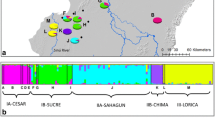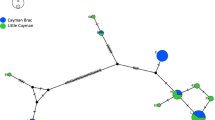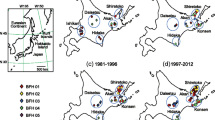Abstract
Endemic and endangered species are highly vulnerable to habitat perturbations and may be subject to variations in their population size. Management plan for these species is crucial to avoid population decline, loss of genetic variability, inbreeding and ultimately extinction. The sand lizard, Liolaemus lutzae, is endemic to a habitat of sandy coastal plain (restinga). Its geographical distribution extends for only 200 km stretch of the coast of Rio de Janeiro state, Brazil, one of South America’s most densely populated regions. Extensive development and degradation of the beaches where the species inhabits, have led to the species becoming critically endangered. We used mitochondrial DNA sequences and microsatellite loci to resolve patterns of population connectivity and genetic variation within the species in order to provide a platform for a species management plan. Our results indicate the existence of three main populations, separated from each other by the Guanabara Bay and by the Arraial do Cabo Peninsula. The low microsatellite genetic variation and heterozygosity witnessed in each of the three populations, together with high levels of inbreeding and low effective population sizes suggest that the species is in urgent need of intensive management. Based on the results of this study we propose strong measures to protect existing restinga fragments and the implementation of programmes of captive breeding and reintroduction of individuals from the heavily threatened regions to protected refugia. Such measures may be the only way of ensuring the continuity of the species.


Similar content being viewed by others
References
Armstrong DP, Seddon PJ (2008) Directions in reintroduction biology. Trends Ecol Evol 23:20–25
Barth OM, Barreto CF, Coelho LG, Luz CFP (2004) Pollen record and paleoenvironment of a 4210 years b.p.old sediment in the Bay of Guanabara, Rio de Janeiro, Brazil. An Acad Bras Cienc 76:549–551
Barth OM, São-Thiago LEU, Barros MA (2006) Paleoenvironment interpretation of a 1760 years b.p. old sediment in a mangrove area of the Bay of Guanabara, using pollen analysis. An Acad Bras Cienc 78:227–229
Brussard P (1984) Geographic patterns and environmental gradients: the central-marginal model in Drosophila revisited. Annu Rev Ecol Syst 15:25–64
Clement M, Posada D, Crandall KA (2000) TCS: a computer program to estimate gene genealogies. Mol Ecol 9:1657–1659
Cornuet JM, Luikart G (1996) Description and power analysis of two tests for detecting recent population bottlenecks from allele frequency data. Genetics 144:2001–2014
Dupanloup I, Schneider S, Excoffier L (2002) A simulated annealing approach to define the genetic structure of populations. Mol Ecol 11:2571–2581
Eckert CG, Samis KE, Lougheed SC (2008) Genetic variation across species’ geographical ranges: the central-marginal hypothesis and beyond. Mol Ecol 17:1170–1188
Evanno G, Regnaut S, Goudet J (2005) Detecting the number of clusters of individuals using the software structure: a simulation study. Mol Ecol 14:2611–2620
Frankham R (2005) Genetics and Extinction. Biol Conserv 126:131–140
IUCN (2012) IUCN Red List of Threatened Species. Version 2012.2. Available at www.iucnredlist.org (downloaded 9 February 2012). International Union for Conservation of Nature (IUCN), Cambridge, UK
Jordan MA, Hammond RL, Snell HL, Snell HM, Jordan WC (2002) Isolation and characterization of microsatellite loci from Galapagos lava lizards (Microlophus spp.). Mol Ecol Notes 2:349–351
Jordan MA, Snell HL, Snell HM, Jordan WC (2005) Phenotypic divergence despite high levels of gene flow in Galapagos lava lizards (Microlophus albemarlensis). Mol Ecol 14:859–867
Kalinowski ST (2005) HP-RARE 1.0: a computer program for performing rarefaction on measures of allelic richness. Mol Ecol 5:187–189
Keller L, Waller D (2010) Inbreeding effects in wild populations. Trends Ecol Evol 17:230–241
Lande R (1994) Risk of population extinction from fixation of new deleterious mutations. Evolution 48:1460–1469
Librado P, Rozas J (2009) DnaSP v5: a software for comprehensive analysis of DNA polymorphism data. Bioinformatics 25:1451–1452
Luikart G, Allendorf FW, Cornuet JM, Sherwin WB (1998) Distortion of allele frequency distributions provided a test for recent population bottlenecks. J Hered 89:238–247
Lynch M, Conery J, Burger R (1995) Mutation accumulation and the extinction of small populations. Am Nat 146:489–518
Maia-Carneiro T, Rocha CFD (2013a) Influences of sex, ontogeny and body size on the thermal ecology of Liolaemus lutzae (Squamata, Liolaemidae) in a restinga remnant in southeastern Brazil. J Therm Biol 38:41–46
Maia-Carneiro T, Rocha CFD (2013b) The behaviour of orientation of openings of burrows by Liolaemus lutzae (Squamata: Liolaemidae): is it influenced by environmental factors? J Nat Hist 47:253–262
Maia-Carneiro T, Dorigo TA, Rocha CFD (2012) Influences of seasonality, thermal environment and wind intensity on the thermal ecology of Brazilian sand lizards in a restinga remnant. South Am J Herpetol 7:241–251
Martin L, Fournier M, Mourguiart P, Sifeddine A, Turcq B, Absy ML (1993) Southern oscillation signal in south american palaeoclimatic data of the last 7,000 years. Quat Res 39:338–346
Mausfeld P, Schmitz A, Böhme W, Misof B, Vrcibradic D, Rocha CFD (2002) Phylogenetic affinities of Mabuya atlantica Schmidt, 1945, endemic to the atlantic ocean archipelago of Fernando de Noronha (Brazil): necessity of partitioning the genus Fitzinger, 1826 (Scincidae: Lygosominae). Zoologischer Anzeiger 241:281–293
Muehe D, Belligotti FM, Lins-de-Barros FM, Oliveira JF, Maia LFPG (2010) Potential vulnerability to climate change of the beach-dune system of the Peró coastal plain, Rio de Janeiro, Brazil. Panamjas 5:267–276
Murphy AR, Gardner MG, Fox SF (2009) Isolation of microsatellites via enrichment and a sequence tagged method in a South American lizard with suspected parental care, Liolaemus leopardinus. Conserv Genet Resour 1:13–16
Myers N, Mittermeier RA, Mittermeier CG, Fonseca GA, Kent J (2000) Biodiversity hotspots for conservation priorities. Nature 403:853–858
Oliveira LAP, Saboia AL, Belchior JR, Cunha LM (2008) A síntese de indicadores sociais 2008. Instituto Brasilieiro de Geografia e Estatística, Rio de Janeiro
Palumbi SR (1996) Nucleic acids II : the polymerase chain reaction. In: Hillis DM, Moritz C, Mable BK (eds) Molecular systematics. Sinauer, Sunderland, pp 205–247
Peakall R, Smouse PE (2006) Genalex 6: genetic analysis in Excel. Population genetic software for teaching and research. Mol Ecol Notes 6:288–295
Peakall R, Smouse PE (2012) Genalex 6.5: genetic analysis in Excel. Population genetic software for teaching and research. Bioinformatics 28:2537–2539
Pritchard JK, Stephens M, Donnelly P (2000) Inference of population structure using multilocus genotype data. Genetics 155:945–959
Raymond M, Rousset F (1995) GENEPOP (version 1.2): population genetics software for exact tests and ecumenicism. J Hered 86:248–249
Rignot E, Velicogna I, van den Broeke MR, Monaghan A, Lenaerts J (2011) Acceleration of the contribution of the Greenland and Antarctic ice sheets to sea level rise. Geophys Res Lett 38:L05503
Rocha CFD (1988) Ritmo de atividade e microclimatologia do habitat de Liolaemus lutzae (Sauria: Iguanidae). An Sem Reg Ecol 4:269–281
Rocha CFD (1991) Composição do habitat e uso do espaço por Liolaemus lutzae (Sauria: Tropiduridae) em uma área de restinga. Rev Bra Biol 51:839–846
Rocha CFD (1992) Reproductive and fat body cycles of the Tropical sand lizard (Liolaemus lutzae) of Southeastern Brazil. J Herpetol 26:17–23
Rocha CFD (1995) Ecologia termal de Liolaemus lutzae (Sauria: Tropiduridae) em uma área de restinga no sudeste do Brasil. Rev Bras Biol 55:481–489
Rocha CFD (1998) Population dynamics of the endemic tropidurid lizard Liolaemus lutzae in a tropical seasonal restinga habitat. Ciênc Cult 50:446–451
Rocha CFD (1999) Home range of the Tropidurid lizard Liolaemus lutzae: sexual and body size differences. Rev Bras Biol 59:125–130
Rocha CFD, Bergallo HG (1992) Population decrease: the case of Liolaemus lutzae, an endemic lizard of Southeastern Brazil. Ciênc Cult 44:52–54
Rocha CFD, Bergallo HG, Alves MAS, VanSluys M (2003) A biodiversidade nos grandes remanescentes florestais do estado do Rio de Janeiro e nas restingas da Mata Atlântica. Rima, São Carlos
Rocha CFD, Ariani CV, Siqueira CC (2008) Liolaemus lutzae Mertens, 1938. In: Machado ABM, Drummond GM, Paglia AP (eds) Livro vermelho da fauna brasileira ameaçada de extinção Vol II. Fundação Biodiversitas, Brasília, pp 345–347
Rocha CFD, Siqueira CC, Ariani CV (2009a) The endemic and threatened lizard Liolaemus lutzae (Squamata: liolaemidae): current geographic distribution and areas of occurrence with estimated population densities. Zoologia 26:454–460
Rocha CFD, Siqueira CC, Ariani CV (2009b) A potential recovery of a population of the sand lizard Liolaemus lutzae Mertens, 1938 in an area within its range: a lizard endemic and threatened with extinction. Brazil J Biol 69:185–187
Sambrook J, Russel DW (2001) Molecular Cloning: a laboratory manual. Cold Spring Harbor Laboratory Press, New York
Sinervo B, Méndez-De-La-Cruz F, Miles DB, Heulin B, Bastiaans E, Villagrán-Santa Cruz M, Lara-Resendiz R, Martínez-Méndez N, Calderón-Espinosa ML, Meza-Lázaro RN, Gadsden H, Avila LJ, Morando M, De La Riva IJ, Sepulveda PV, Rocha CFD, Ibargüengoytía N, Puntriano CA, Massot M, Lepetz V, Oksanen TA, Chapple DG, Bauer AM, Branch WR, Clobert J, Sites JW (2010) Erosion of lizard diversity by climate change and altered thermal niches. Science 328:894–899
Soares AHB, Araujo AFBD (2008) Experimental introduction of Liolaemus lutzae (Squamata : Iguanidae) in Praia das Neves, State of Espírito Santo, Brazil: a descriptive study 18 years later. Rev Bras Zool 25:640–646
Suguio K, Tessler MG (1984) Planícies de cordões arenosos Quaternários do Brasil: origem e nomenclatura. In: Lacerda LD, Araújo DSD, Cerqueira R, Turcq B (eds) Restingas: origem, estrutura. Processos, CEUFF, pp 15–26
Suguio K, Martin L, Bitencourt A, Dominguez J, Flexo R, Azevedo A (1985) Flutuações do nível relativo do mar durante o Quaternário Superior ao longo do litoral brasileiro e suas implicações na sedimentação costeira. Rev Bras Geocienc 15:273–286
Thomas CD, Cameron A, Green RE, Bakkenes M, Beaumont LJ, Collingham YC, Erasmus BFN, Siqueira MFD, Grainger A, Hannah L, Hughes L, Huntley B, Jaarsveld ASV, Midgley GF, Miles L, Ortega-Huerta MA, Peterson AT, Phillips OL, Williams SE (2004) Extinction risk from climate change. Nature 427:145–148
Vanzolini PE, Ab’Saber AN (1968) Divergence rate in South American lizards of the genus Liolaemus (Sauria, Iguanidae). Papéis Avulsos de Zoologia 21:205–208
Varjabedian R (2010) Atlantic rainforest law: environmental regression. Estudos Avançados 23:147–160
Vucetich JA, Waite TA (2003) Spatial patterns of demography and genetic processes across the species’ range : null hypotheses for landscape conservation genetics. Conserv Genet 4:639–645
Wang J (2011) Coancestry: a program for simulating, estimating and analysing relatedness and inbreeding coefficients. Mol Ecol Resour 11:141–145
Waples RS, Do C (2008) Ldne: a program for estimating effective population size from data on linkage disequilibrium. Mol Ecol Resour 8:753–756
Acknowledgments
We would like to thank Gisele Winck, Laboratório de Ecologia de Vertebrados (UERJ), for collecting extra samples of Liolaemus lutzae. We are grateful to Dr Jim Groombridge, of the University of Kent, Dr Davor Vrcibradic, of the Universidade Federal do Estado do Rio de Janeiro, and Dr Punita Juneja and Dr Andrea Manica from the University of Cambridge who gave helpful advice on this manuscript. CFDR received grants from Conselho Nacional do Desenvolvimento Científico e Tecnológico-CNPq (Processes 304791/2010-5 and 472287/2012-5) and from Fundação Carlos Chagas de Amparo à Pesquisa do Estado do Rio de Janeiro-FAPERJ (Process E-26.102.765/2012) through Programa Cientistas do Nosso Estado.
Author information
Authors and Affiliations
Corresponding author
Additional information
William C. Jordan—Deceased.
Electronic supplementary material
Below is the link to the electronic supplementary material.
Rights and permissions
About this article
Cite this article
Ariani, C.V., Pickles, R.S.A., Jordan, W.C. et al. Mitochondrial DNA and microsatellite loci data supporting a management plan for a critically endangered lizard from Brazil. Conserv Genet 14, 943–951 (2013). https://doi.org/10.1007/s10592-013-0484-9
Received:
Accepted:
Published:
Issue Date:
DOI: https://doi.org/10.1007/s10592-013-0484-9




